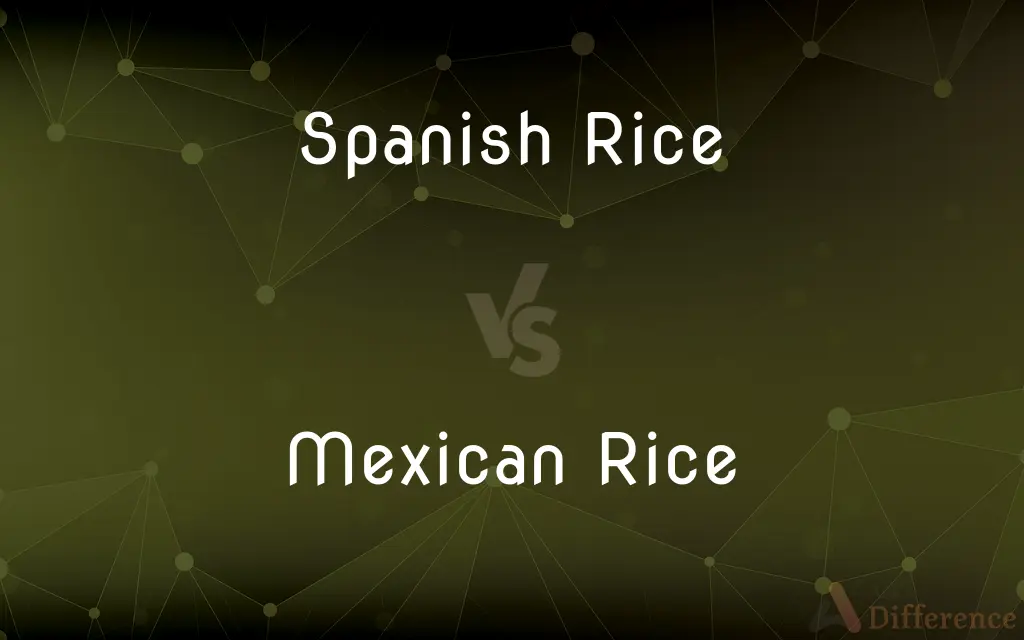Spanish Rice vs. Mexican Rice — What's the Difference?
Edited by Tayyaba Rehman — By Fiza Rafique — Published on November 20, 2023
Spanish Rice, often saffron-flavored and yellow, is used in a variety of dishes. Mexican Rice is usually light brown, cooked with tomatoes, and served as a side dish, often with beans or used in burritos.

Difference Between Spanish Rice and Mexican Rice
Table of Contents
ADVERTISEMENT
Key Differences
Spanish Rice is known for its distinctive yellow hue, typically derived from the use of saffron, a spice that not only imparts color but also a unique, earthy flavor. On the other hand, Mexican Rice, often noticed for its light brown or reddish color, generally attains its tint from tomatoes, which are often blended and then cooked with the rice, adding a slightly tangy and savory flavor.
Spanish Rice serves as a critical component in various dishes, such as paella, where it is melded with an array of seafood, meats, and vegetables. Contrarily, Mexican Rice, typically garnished with fresh items like peas and carrots, is most commonly utilized as a side dish, complementing main entrees like enchiladas or tacos and can also be used as a filling in dishes like stuffed peppers or burritos.
Spanish Rice can often be found as an integral, mingling part of a larger dish, with its saffron-infused grains interplaying with other ingredients to create a symphony of flavors and textures. Whereas Mexican Rice, while it can be included within larger concoctions like casseroles, more frequently stands alone beside other components of a meal, acting as a flavorful, savory counterpart to often spicy and rich dishes.
Spanish Rice, with its subtly aromatic and slightly floral notes from saffron, tends to play well with the bolder, more robust elements of various meats and seafood. In contrast, Mexican Rice, with its tomato-based zest and often inclusion of cumin, garlic, and onions, projects a hearty and savory profile, which provides a delightful contrast to the other elements on the plate, such as beans, guacamole, or chili.
Comparison Chart
Primary Coloring Agent
Saffron
Tomatoes
ADVERTISEMENT
Common Usage
Integral part of dishes like paella
Often used as a side dish
Typical Color
Yellow
Light brown or reddish
Flavor Profile
Slightly floral, earthy due to saffron
Savory and mildly tangy due to tomatoes
Complementary Ingredients
Seafood, meats, and vegetables
Beans, peas, carrots, and sometimes used in burritos
Compare with Definitions
Spanish Rice
Rice that often mingles with other ingredients like seafood and vegetables.
Spanish Rice is often enveloped with peas, prawns, and other ingredients in paella.
Mexican Rice
Rice that generally carries a savory and slightly tangy flavor.
The robust, tangy flavor of Mexican Rice paired well with the spicy chicken.
Spanish Rice
Often used as an integral ingredient in various dishes.
The Spanish Rice beautifully absorbed the rich flavors of the seafood stew.
Mexican Rice
Rice that is sometimes utilized as a filling in dishes like burritos.
The burrito was hearty and fulfilling with the inclusion of Mexican Rice.
Spanish Rice
Rice colored with saffron, imparting a yellow hue.
The paella featured a bed of flavorful Spanish Rice.
Mexican Rice
Rice typically cooked with tomatoes, providing a reddish hue.
The Mexican Rice added a lovely, colorful side to the meal.
Spanish Rice
Rice that is known for its slightly earthy, floral flavor due to saffron.
Spanish Rice offers a delicate flavor balance in the hearty meat dish.
Mexican Rice
A staple in Mexican and Tex-Mex cuisines.
Mexican Rice served as a flavorful filling in the stuffed peppers.
Spanish Rice
A staple in various Spanish and sometimes Mediterranean dishes.
The Spanish Rice complemented the grilled vegetables splendidly.
Mexican Rice
Often utilized as a side dish in various meals.
Mexican Rice and beans created a satisfying, hearty side.
Common Curiosities
What gives Mexican Rice its color?
It is usually the tomatoes that give Mexican Rice its color.
Is Spanish Rice always yellow?
Typically yes, due to the use of saffron.
What meats commonly pair with Spanish Rice?
Various meats like chicken, rabbit, and seafood are used.
Is Mexican Rice vegetarian?
Often yes, but check recipes for chicken stock or other non-vegetarian ingredients.
Is Spanish Rice used in paella?
Yes, it's a key component in traditional paella.
Is Mexican Rice spicy?
It's mildly savory but not typically spicy.
Can Mexican Rice be used as a main dish?
Typically it's a side, but can be a base for a main dish like in a casserole.
Is saffron necessary for Spanish Rice?
Traditional Spanish Rice uses saffron, but it can be omitted or substituted.
Can I use other spices instead of saffron in Spanish Rice?
Yes, but saffron is traditional for authentic Spanish Rice.
Does Mexican Rice contain beans?
Not usually within the rice, but it's often served alongside beans.
What vegetables are in Mexican Rice?
Often peas, carrots, and sometimes peppers.
Can I use Mexican Rice in a burrito?
Yes, it’s commonly used as a burrito filling.
Does Spanish Rice contain seafood?
In some dishes, like paella, it is combined with seafood.
Is Spanish Rice gluten-free?
Typically yes, but always check specific recipes for additives.
Can Spanish Rice be a standalone dish?
It’s usually part of a dish but can be enjoyed alone.
Share Your Discovery

Previous Comparison
Parcel Post vs. Express Post
Next Comparison
Ammonia vs. Ammonium NitrateAuthor Spotlight
Written by
Fiza RafiqueFiza Rafique is a skilled content writer at AskDifference.com, where she meticulously refines and enhances written pieces. Drawing from her vast editorial expertise, Fiza ensures clarity, accuracy, and precision in every article. Passionate about language, she continually seeks to elevate the quality of content for readers worldwide.
Edited by
Tayyaba RehmanTayyaba Rehman is a distinguished writer, currently serving as a primary contributor to askdifference.com. As a researcher in semantics and etymology, Tayyaba's passion for the complexity of languages and their distinctions has found a perfect home on the platform. Tayyaba delves into the intricacies of language, distinguishing between commonly confused words and phrases, thereby providing clarity for readers worldwide.
















































